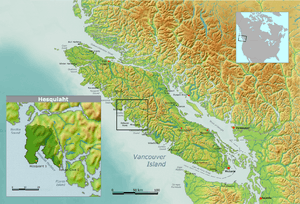Hesquiaht First Nation

The Hesquiaht First Nation (pronounced Hesh-kwit or Hes-kwee-at) is a Nuu-chah-nulth First Nations band government based on the west coast of Vancouver Island in British Columbia, Canada. It is a member of the Nuu-chah-nulth Tribal Council.
Introduction

Hesquiaht is the most northerly and remote of the five Central Region Nuu-chah-nulth Nations. Two of eight Hesquiaht Reserves are occupied by Hesquiaht members, one at Hot Springs Cove and the other at Hesquiaht Harbour. Hot Springs Cove is named after the natural hot springs located at the south end of a narrow peninsula on the east side of the cove. The Reserve Community of Hot Springs (Refuge Cove) village is located on the cove’s west side, home to approximately 80 individuals and 25 families (39 dwellings). The community had to rebuild after a tsunami in 1964. With a population of approximately 150 people living in Hot Springs Cove and a commute of over one hour by boat into Tofino, the Hesquiaht are used to living in isolation.
And thus distance from services defines the challenges and opportunities for the Hesquiaht more than for any other community in the Clayoquot region. While for visitors a trip to the hot springs, Hesquiaht Harbour, Hooksum Outdoor School, or Cougar Annie’s Garden are adventures into hard-to-access wilderness, for Hesquiaht it is simply a necessary commute to the nearest grocery store or to visit the three quarters of the membership that live in Port Alberni, Nanaimo, Vancouver and Victoria.
To compound the impact of physical isolation, the Hesquiaht were devastated by the 1990s economic collapse of their traditional fisheries and forestry activities. Adding to the problem, the community is still recovering from the effects of the 1960s tsunami that wiped out the village and forced many people to move away. The Hesquiaht are mindful that the future of the Hesquiaht nation needs to be grounded on spirituality, healing and reconciliation to retain and re-attract the membership to Hesquiaht territory.
Hereditary System (Klukwana)
Prior to the 19th century, the Hesquiaht were a congregation of five small nations living around Hesquiaht Harbour, with a total population of about 6,000 to 10,000 individuals. Each nation was governed by their respective Ha’wiih (hereditary) system. After the smallpox epidemic, the communities moved to one site at Hesquiaht Village, before being moved by Indian Affairs to the current site at Hot Springs Cove. The Hot Springs Cove reserve is located on territory claimed by the Ahousaht First Nation.
The Ha’wiih system still functions in Hesquiaht. Four hereditary chiefs guide the community and inform the work of council. The chiefs sit hierarchically as one looks at the four fingers of the hand. The Ha'wiih are:
- Kathleen Andrews-Thomas - Ta'hii (Head Hereditary Chief) (Middle finger), House of Kaaeth Klaahish Takuumth (includes the Charleson, Ignace and Mickey families)
- Vince Ambrose (ring finger) (Ambrose, Lucas families)
- Steve Tom (index finger) (Tom, Sabbas, Webster families)
- Eddie Jones (small finger) (Jones, Lucas and Ginger families)
One interesting feature of Klukwana (the traditional governance system) is the continued existence of Tikawiilth, those who manage the nation’s affairs on behalf of the hereditary chiefs. The Tikawiilth traditionally manage the affairs of the hereditary chiefs, which in modern times often coincides with role of Chief and Council. The current Tikawiilth are: Pat Charleson (Head Wolf Chief) - (thumb), Larry Paul, Remi Charleson, Eugene August, Chancellor Amos
Elected system
Hesquiaht Council is elected every four years, with the next term of office expiring on November 25, 2014. Chief and Council meets monthly, and a joint Chief and Council, membership, and Hereditary Chiefs meeting is held yearly at the AGM. The Chief and Council are responsible for management of band affairs. The Chief and Council, and their portfolios include:
- Victor Amos, Chief Councillor: Fisheries, Governance & Culture
- April Charleson, Councillor: Economic Development, Finances & Personnel
- Estella Charleson, Councillor: Treaty, Justice & Youth/Recreation
- Constance Charleson, Councillor: Fisheries, Culture, & Youth/Recreation (Off-Reserve)
- Felix Jackson, Councillor: Finances, Personnel, Housing & Treaty (On-Reserve)
- Jessie Jim, Councillor: Communications, Education, Finances & Elders (Off-Reserve)
- Claudette Lucas, Councillor: Health & Welfare, Education
Administration
The Hesquiaht Chief and Council rely on administrators to conduct the day-to-day management of tribal affairs, program delivery, and coordination with government agencies.
Business and Economic Development
The Hesquiaht Chief and Council operate businesses in Hot Springs Cove, which includes: The Hesquiaht Council is currently weighing the option of private arrangements for some of these businesses. In addition, fisheries historically were one of the strongest sources of employment, and the Nation was known, amongst other things, for its boat building yard and associated skills. Operating in coordination with, but independent from, Council, Hesquiaht still has active fishermen.
Community opportunities
As one of the most isolated communities in the Clayoquot region, the future of the Hesquiaht First Nation on their traditional territory is dependent on affordable and sustainable transportation systems, on the development of community infrastructure and sustainable energy production, and on keeping or re-attracting its members to the community.
Starting with health and social development—the key starting point—the Hesquiaht is working on a number of fronts to keep the community thriving. These include the development of eco-tourism opportunities, infrastructure and housing, treaty negotiations, and the marketing of the community and territory.
References
- Ecotrust Canada. "The Hesquiaht Nation," in Daniel Arbour, Brenda Kuecks & Danielle Edwards (editors). Nuu-chah-nulth Central Region First Nations Governance Structures 2007/2008, Vancouver, September 2008.
External links
| Wikimedia Commons has media related to Hesquiaht. |